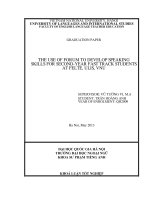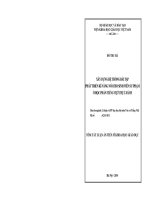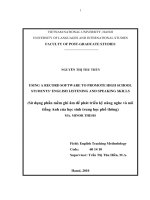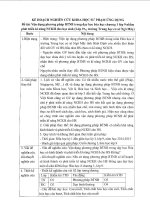Sử dụng hoạt động đóng vai để phát triển kĩ năng nói cho học sinh của trường tiểu học hùng sơn
Bạn đang xem bản rút gọn của tài liệu. Xem và tải ngay bản đầy đủ của tài liệu tại đây (481.51 KB, 95 trang )
THAI NGUYEN UNIVERSITY
SCHOOL OF FOREIGN LANGUAGES
TRUONG THI KIM NHI
USING ROLE PLAY TO DEVELOP SPEAKING SKILL FOR
STUDENTS IN HUNG SON PRIMARY SCHOOL
(Sử dụng hoạt động đóng vai để phát triển kĩ năng nói cho học sinh
của trường tiểu học Hùng Sơn)
M.A. THESIS
(APPLICATION ORIENTATION)
Field: English Linguistics
Code: 8220201
Supervisor: Dr. Nguyen Thi Viet Nga
THAI NGUYEN – 2018
i
DECLARATION
-----------*****----------I certify that the minor thesis entitled “Using role play to develop speaking
skill for students in Hung Son primary school” is my own study in the fulfillment
of the requirement for the Degree of Master of Arts at Foreign Language Faculty,
Thai Nguyen University.
Signature:
Truong Thi Kim Nhi
Thai Nguyen, 2018.
ii
ACKNOWLEDGEMENTS
During the process of completing this graduation paper, I have been fortunate to
receive much support, assistance, guidance encouragement from many people.
First of all, I would like to express my deepest gratitude to my supervisor – Mrs.
Nguyen Thi Viet Nga, Ph.D. who has kindly given me constructive comments,
criticism, suggestions.
In addition, my thanks also are sent to all the teachers of College of Foreign
Languages at Thai Nguyen University who have taught me with all their heart in
unforgettable two years. They have directly and indirectly contributed to the
completion of this research.
I also wish to give my deepest thanks to my family who has been
wholeheartedly supporting me. They are always beside and motivate me in my
study and my life. Finally, I also would like to thank all my friends for their
discussions, opinions and encouragements. Without their instructive
contributions, my research could have been finished.
Moreover, the shortcomings in this study are unavoidable. Therefore, I hope to
receive the sympathy from teachers and friends.
Thai Nguyen, 2018
Truong Thi Kim Nhi
3
TABLE OF CONTENTS
DECLARATION……………………………………………………………….…....i
ACKNOWLEDGEMENTS………………………………………………….….....ii TABLE OF
CONTENTS………………………………………………..………...iii
ABSTRACT…………………………………………………….…..........................vi LIST OF FIGURES,
ABBREVIATIONS, TABLES AND CHARTS ……….….viii CHAPTER 1: INTRODUCTION.
..............................................................................1
1.1. Rationale ..............................................................................................................1
1.2. Aims of the study .................................................................................................2
1.3. Research questions
...............................................................................................2
1.4. Scope of the study
................................................................................................2
1.5. Significance of the research. ................................................................................2
1.6. Structure of the thesis
...........................................................................................3
CHAPTER 2: LITERATURE REVIEW ....................................................................4
2.1. Speaking. ..............................................................................................................4
2.1.1. Definition of speaking .......................................................................................4
2.1.2. Elements of speaking. .......................................................................................4
2.1.3. Types of speaking. ............................................................................................6
2.2. Teaching speaking for primary students. .............................................................7
2.2.1 Teaching speaking..............................................................................................7
2.2.2. How to teach speaking for primary
students.....................................................8
2.3. Using role-playing activities teaching speaking for primary students .................9
2.3.1. Role- play ..........................................................................................................9
2.3.2. Types of role play............................................................................................10
2.3.3. The organization of a role - play activity. .......................................................10
4
2.3.4. The teacher’s and student’s role in role play activity. ....................................11
2.3.5. The advantages of role play activity. ..............................................................12
2.3.6. The disadvantages of role play activity...........................................................13
5
2.4. Review of Related Studies. ................................................................................14
CHAPTER 3: METHODOLOGY ............................................................................16
3.1. Research questions
.............................................................................................16
3.2. Participants
.........................................................................................................16
3.3. Data collection instrument.
................................................................................16
3.3.1. Observation. ....................................................................................................17
3.3.2. Interview .........................................................................................................17
3.3.3. Test. .................................................................................................................18
3.4. Research procedure
............................................................................................20
3.5. Data analysis. .....................................................................................................23
CHAPTER 4: FINDINGS AND DISCUSSION. .....................................................25
4.1. Findings of the Observation. ..............................................................................25
4.1.1. The result of pre observation.
.........................................................................25
4.1.2. The result of observation after implementing the Class Action Research. .....25
4.2. Findings of the Interview ...................................................................................26
4.3. The result of the test.
..........................................................................................28
4.3.1. The result of pre –
test.....................................................................................28
4.3.1 Findings of the first cycle.................................................................................28
4.3.2 Findings of the second cycle. ...........................................................................34
4.4.3. Findings of the Test Results. ...........................................................................38
CHAPTER 5: CONCLUSION AND SUGGESTIONS............................................46
5.1. Recapitulation ....................................................................................................46
5.2. Suggestions ........................................................................................................46
5
5.2.1. For teachers.
....................................................................................................46
5.2.2. For students
.....................................................................................................47
5.2.3. For the researchers:
.........................................................................................48
5.3. Limitations: ........................................................................................................48
REFERENCES..........................................................................................................49
APPENDIXES ............................................................................................................ I
6
ABSTRACT
The aim of this research is to enhance students’ activity in learning speaking
skill, to check whether role play is efective learning technique, to know advantages
and disadvantages of role play. The research subject is fifth grade students of Hung
Son Primary School which is located in Hung Son town, Dai Tu district, Thai Nguyen
province. This research was classroom action research that conducted into two
cycles. In each cycle was consisted of plan, action, observation, and reflection. Data
collection techniques used are interviews, observations and tests. In this
research, the researcher acted as the practitioner. The tests were in the form of
pre- test conducted in the pre-research and post-tests conducted at the end of
every cycle. These tests were conducted to know how well students speak English
by using role play in teaching English.
The results of this research showed that the use of role-play can improve the
students’ speaking competence, role play is an effective technique of learning, and
there are some advantages besides the disadvantages. From the observations, it
can be seen that the students could speak well and improve their vocabularies and
grammatical structure. Using role play in speaking class could increase the
student’s scores in learning speaking. It can be proved by the improvement of
motivation of students. There were 7 students or 11.67 % of students in the class
who achieved the minimal mastery level criterion or KKM (65) in the pre – test. In
the result of post – test in cycle 1, there were 22 or 36.67 % of the students who
achieved KKM. In the result of post –test in cycle 2, there were 53 or 88.33 %
of the students who achieved KKM, and it means this action research is
successful.
Based on the research finding above, at the end of this research, the
researcher wants to propose some suggestions to English teachers. First, before
conducting the instructional process especially in speaking class, choosing the
7
most suitable way of improving the students’ motivation in learning speaking
is important because this is the key of the success in teaching-learning process.
Besides, it is necessary to create an interesting and enjoyable atmosphere in the
teaching learning
8
process in order to make the students easier in improving their speaking
competence.
vii
LIST OF FIGURES, ABBREVIATIONS, TABLES AND CHARTS
1. Figures:
Figure 1: Kurt Lewin’s Action Research Design………………………………..21
Figure 2: The Phases of Classroom Action Research (Adapted from Kurt Lewin’s
Action Research Design)……………………………………………….………22
2. Abbreviations:
CLT: Communicative Language Teaching……………………………………12
CAR: Classroom Action Research……………………………………………..17
KKM: Criterion Minimum of Completeness………………………………….29
3. Tables:
Table 1: Assessing Students’ Progress…………………………………………..17
Table 2: The Rating Scores of Oral Test …………………………….…………18
Table 3: The students’ participation in speaking during CAR………….…….24
Table 4: The students’ participation in speaking during cycle 1…….….……31
Table 5: The students’ participation in speaking during cycle 2……..……..…36
Table 6: The students’ speaking score of pre – test, post – test 1, post - test 2..37
Table 7: The distribution of the students score…………………………………39
4. Charts:
Chart 1: The Students’ Score Mean Improvement……………………………41
Chart 2: The Students’ Score Class Percentage (pre - test, post - test I, post – test
II)……………………………………………………………………………42
viii
CHAPTER 1: INTRODUCTION
1.1. Ratonale
English is an international language used in order to communicate in the fields of
education, technology, trade and politics so that it is learnt as a foreign language
in many countries around the world. In Viet Nam, speaking is appreciated as an
important skill in teaching English for primary students. Nowadays, the students
faced a number of difficulties in learning speaking skill.
The first problem students faced in speaking skill was they did not have suficient
vocabulary, because of this; they found it difficult to express their ideas when
the teacher wanted them to speak in English. The second problem was the
students felt afraid if they made some mistakes when they conversed in English.
Therefore, many students were not confident to speak and take part in classroom
interaction. The third problem that the students faced in learning speaking skill
was they had very limited time to practice their English because they only
practiced their English at school, and after they returned home from school they
did not use English anymore. Moreover, the students just have an opportunity in
classroom which is a contrived situation that does not always make the
opportunity for students to practice natural speaking. Consequently, the students
thought that their performance in English was still low.
Because of these problems, in order to activate and motivate students in learning
speaking, teachers should use efective techniques for the teaching of speaking.
One of the most popular activities used is role play which is a very useful technique
in teaching speaking language. Ur (1981) stated that “The use of the play has added
a tremendous number of possibilities for communication practice”. Barkley (2004,
p.
150) said that “Role Play is a created situation in which students deliberately act
out or assume characters or identities they would not normally assume in order to
accomplish learning goal”. It means the activity helps create interaction in the
1
language classroom. It is practical, entertaining, and gets students to produce
authentic English. Additionally, it can motivate the learners and establish good
2
relationships between the teacher and the students as well as among the
students thereby encouraging a supportive environment for language learning.
Deriving from the above mentioned reasons, “Using role play to develop
speaking skill for students in Hung Son primary school” is made. The researcher
hopes that this study will provide the teachers of primary school a suitable
method to teach speaking for primary students.
1.2. Aims of the study
This study had two aims:
- To find out whether role-play improves the speaking competence of
students at Hung Son primary school.
- To find out the advantages and disadvantages while applying role-play to
students at Hung Son primary school
1.3. Research questons
- How efective are role-playing activities in improving students’ speaking skills
at Hung Son primary school?
- What are the advantages and disadvantages of using role-play to teach
speaking English skill?
1.4. Scope of the study
The scope of the research focused on developing speaking skill for students in
grade
5 in Hung Son Primary School by using role play. Any other related issues should
be included in further research.
1.5. Significance of the research
“Using role play to develop speaking skill for students in Hung Son Primary
School” is a research which is expected to be able to give some benefits for
teachers, learners and readers.
For teachers, this study can give more meaning and deeper understanding for the
English teachers for the innovative and creative methods that can be applied
in teaching speaking.
For students, the role-playing activities can provide a more comforting and
interesting situation in the classroom so that they are more interested in joining
the class.
For readers, the research can be used as additional reference for those who want
to conduct research an English teaching process by using role-playing activities,
especially in improving students’ English speaking ability.
1.6. Structure of the thesis
The thesis consists of five chapters:
Chapter 1, Introducton, presents the background to the study, states the aims of
the study. The significance and scope of the study are also discussed.
Chapter 2, Literature Review, provides the theoretical basis. Besides, the related
ideas in previous researches are included in this chapter. This chapter contains 3
sections: Speaking, Teaching Speaking and Using role-playing activities for
teaching speaking for primary student.
Chapter 3, Methodology, focuses on the methods used to gather and analyze data.
First, research questions are addressed. Then, instruments for data collection and
participants are described. The chapter ends with analyzing data.
Chapter 4, Finding and Discussion, in this part, the findings of the research will be
presented and then will be discussed.
Chapter 5, Conclusion, summarize the findings of the research. After that, the
limitation of the research as well as the suggestion for further research will also be
included.
CHAPTER 2: LITERATURE REVIEW
This chapter provides the theory and research to support and make the study
more clearly. The first section gives an overview of speaking skill including
definitions and its conception. The second section is about teaching speaking
for primary school. The third section discusses using role-playing activities
teaching speaking for primary students.
2.1. Speaking
2.1.1. Definiton of speaking
Teaching English for primary students focuses on four skills: reading, listening,
speaking and writing. Speaking plays an important role in learning and
understanding any language. Bailey and Nunan (2005, p.2) assert that speaking is
an interactive process of constructing meaning that involves producing, receiving
and processing information. It can be perceived that speaking is a kind of
interaction process involving two or more people (as speaker(s) and listener(s)) in
order to convey and receive the intended information.
Meanwhile, Donough and Shaw (2003, p.134) stated “There are some reason for
speaking involved expressing ideas and opinions: expressing a wish and a desire to
do something; negotiating and/or solving a particular problem; or establishing and
maintaining social relationships and friendships. Besides, fluency, accuracy and
confidence are important goal in speaking.”. Therefore, as a language skill,
speaking is as the main tool of verbal communication because it is a way to express
ideas and opinions directly what we have in our mind.
Based on the previous definitions above, it can be synthesized that speaking
component has the same importance as the other language skills such as listening,
reading and writing. This skill should be mastered by the students in order to
achieve the curriculum expectation.
2.1.2. Elements of speaking
According to Heaton (1990:70), either four or five components of speaking are
recognized:
- Pronunciation
The student can communicate efectively when they have good pronunciation and
intonation even though they have limited vocabulary and grammar. Pronunciation
refers to the traditional or customary utterance of words. It is the way for students
to produce the utterance words clearly when they are speaking (Kline, 2001, p.69).
Moreover, pronunciation includes all those aspects of speech which make for an
easily intelligible flow of speech, including segmental articulation, rhythm,
intonation and phrasing, and more peripherally even gesture, body language and
eye contact.
From the statements above, pronunciation is an essential aspect for the second
language learners to speak English properly.
- Grammar
To arrange correct sentences in a conversation, it is necessary to improve
grammar for students. In An Introduce to Language, Victoria Fromkin and Robert
Rodman (1998, p.14) mention grammar is the sound and the sound patterns, the
basic units of meaning, such as words, and the rules to combine them to form new
sentences. Thus, grammar is a rule that is needed for the students to combine
correct sentences in conversation and to arrange the correct meaning of
sentences based on the context. Grammar plays an important role in speaking
because second language learners do not use grammar structure accurately, they
cannot speak English well.
- Vocabulary
A significant component of speaking English is vocabulary. Vocabulary means the
appropriate diction or the most important thing in a language especially in
speaking; furthermore, it is easy to express our ideas, feeling and thoughts both in
oral or written form when knowing a lot of vocabularies. In spoken language, the
vocabulary tends to be familiar and everyday (Turk, 2003, p.87). Therefore, to
understand and express an opinion, speakers need to build a system of vocabulary
abundantly. Students need to know words, their meanings, how they are spelt and
how they are pronounced. Thus, when teaching vocabulary, the teachers have to
make sure that they explain the meaning as well as the spelling and pronunciation.
- Fluency
Fluency is defined as the ability to speak communicatively, fluently and accurately.
Fluency usually refers to express oral language freely without interruption. In
teaching and learning process, if the teacher wants to check students’ fluency, the
teacher allows students to express themselves freely without interruption. The
aim is to help students speak fluently and with ease. The teacher does not correct
immediately whereas the idea being that too much correction interferes with
the flow of conversation (Pollard, 2008, p.16).
- Comprehension
The last element of speaking is comprehension. Comprehension refers to the
fact that participants fully understand the nature of the research project, even
when procedures are complicated and entail risks (Cohen et al., 2005, p.51). This
element is discussed by both speakers because it can make people get the
information they want. In addition, its function is to make the listeners catch the
information from the speech easily.
2.1.3. Types of speaking
There are a lot of activities in the classrooms that have been oriented to speaking
for real communication. The activities are conducted merely for giving students
opportunities to practice speaking. In his book, Brown (2004, p.141) divided the
basic types of speaking into 5 categories as follows:
-
Imitative
Imitative is the ability to simply imitate a word or phrase or possibly a sentence.
While this is a purely phonetic level of oral production, a number of prosodic,
lexical and grammatical properties of language may be included in the criterion
performance.
-
Intensive
Intensive is the production of short stretches of oral language designed to
demonstrate competence in a narrow band of grammatical, phrasal, lexical or
phonological relationship (such as prosodic element – intonation, stress, rhythm,
juncture). Examples of intensive include reading aloud, sentence and dialog
completion. In this type, the speaker must be aware of semantic properties in
order to be able to respond, but interaction with an interlocutor is minimal at best.
-
Responsive
Responsive includes interaction and test comprehension but at somewhat limited
level of very short conversation, standard greetings and small talk, simple request
and comments.
-
Interactive
The diferent between responsive and interactive speaking is in the length and
complexity of the interaction, which sometimes includes multiple exchanges
and/or multiple participants. Some examples of interactive speaking are interview,
discussion, games, and role-play.
-
Extensive
Extensive type includes speeches, oral presentations, and story-telling during
which the opportunity for oral interaction from listener is either highly limited or
ruled out altogether. This type needs more action and interaction to the listeners.
2.2. Teaching speaking for primary students
2.2.1 Teaching speaking
Brown (2000, p.7) states that “teaching is showing or helping someone to learn
how to do something, giving instructions, guiding in the study of something,
proving with the knowledge, causing to know or understand”.
Hornby (1995, p.37) defines that teaching means giving the instruction to (a
person): give a person (knowledge skill, etc). Meanwhile, speaking is how to make
use of words in an ordinary voice. So, teaching speaking is giving instruction to a
person in order to communicate.
Teaching speaking is the process of teaching students knowledge about the target
language and skill in order that they express their opinions, emotions and interact
to other person in any situation. According to Tarigan (1990, p.3-4) speaking is a
language skill that is developed in child life, which is preceded by listening skill,
and at that period speaking skill is learned. It means that speaking is the
basic language. The goal of teaching speaking skills is to communicate eficiency.
This is
in line with what Nurmaida (2011, p.79) clarifies that “teaching speaking means
teaching students to involve in target language, since speaking course cannot be
separated from conversation itself ”. So, students will be directly involved in
speaking activities whenever they are conducting a conversation.
Hayriye Kayi (2010) defined that teaching speaking is to teach English language
learners to:
a. Produce the English speech sounds and sound patterns
b. Use word and sentence stress, intonation patterns and the rhythm
of the second language.
c. Select appropriate words and sentences according to the proper
social setting, audience, situation and subject matter.
d. Organize their thoughts in a meaningful and logical
sequence. e. Use language as a means of expressing values and
judgments.
f. Use the language quickly and confidently with few unnatural pauses,
which is called as fluency.
In teaching speaking, learners are provided much knowledge to gain their purpose
that is learning to speak competently in English or ‘obtaining of communicative
competence’. In here they can practice to speak directly and get the material
which involved in the speaking, such as: fluency and accuracy.
Regarding the teachers, they become a guide for directing their students’ speaking
activities, analysis what their students’ problems while the activities is taking place
and after conducted it. Communication strategies are also implemented by
the teachers for their students. It may be, when their students lack of words,
phrases, or structures when they are speaking.
2.2.2. How to teach speaking for primary students
According to McKay (2006), young learners of English are children between 5 and
12 years old who are learning a foreign or second language. They are easy to be
interested in new things but get distracted due to their short attention span, which
lasts from 10 to 15 minutes only. Therefore, teacher must design many activities
which are not only simple but also creative. Moreover each leaner has
diferent









